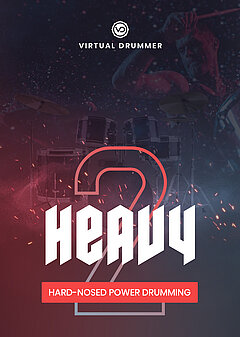How to Give Metal Riffs Punch with Kicks
Turn up the heat on your guitar riffs with hard-hitting metal kicks, and never worry about a weak intro again
SEPTEMBER 6TH , 2020
This is a continuation of our How to Create a Metal Riff article, focused on how to make your guitar riffs stronger and get the most out of your metal kick drum. To get the most use out of this article, make sure you already have a few guitar riffs recorded; that will make it much easier to try out different drum rhythms on the fly. When in doubt, refer to the examples in the metal riff article for inspiration.
Guitar x drums
Here’s a winning formula for building up your riffs:
- Start with solo guitar
- Bring in minimal percussion
- Come in full force with the kick doubling key part of the guitar riff
If you listen closely to the relationship between the guitar and drums, you’ll find that many riffs have the kick accentuating key rhythmic parts of the guitar, followed by a strong snare hit on beats 2 and 4. This keeps the whole rhythm fluid without losing the core beat.
9 times out of 10, you’ll get the best results by starting with guitar (and that’s how a lot of famous metal songs start out). Then the drum kit becomes a heavy support role with its foundation in the kick. Let the guitar lead, and look for opportunities to double the guitar and add a lot of punch.
Metal and rock patterns that hit listeners in the chest
Listeners tire quickly of the kick on 1 and 3, snare on 2 and 4, and a few hi-hats in between. You need something extra. The kick always needs to stay the foundation of the drum kit (with rare exceptions), so focus your attention on where to add extra hits that give things a bit more spice.
Anticipations are great: add a kick one 16th note before the snare, especially if it mirrors the rhythm of the guitar. The bassy hit before the crisp attack gives the snare an additional “pop” and injects more energy into the entire groove, giving the guitar riff more power and hooking listeners for the ride.
There is also, of course, the infamous “double kick”--where the drummer hooks up two pedals to the kick drum and alternates their foot work to get ultra-fast kick patterns. It’s not suitable for every song and can easily be overused, but heavier songs like Trivium’s Sever the Hand wouldn’t be the same without them. (Naturally, double kick drumming is most suited to heavy metal.)
It may seem underwhelming, but the simplest option is to play the kick drum every single beat (the opening to Crazy Train is a perfect example). If no rhythm sounds correct, it might be because the guitar riff is straightforward and needs an equally straightforward kick pattern. Sometimes rock star drums don’t seem terribly exciting on the surface, but that’s better than making your drums sound forced. The kick needs a supportive role, and that sometimes comes without any glamor.
Using metal kicks with a virtual drum kit
Time to take everything here and run with it! Virtual Drummer Heavy is a great tool for metal and rock, and the kick and snare hit exceptionally hard (perfect for accentuating the guitar). Follow the Metal Riff article and make sure you have the guitar part down first. Once you have the feel exactly how you want it, it’s time to add in the drums. Perhaps unsurprisingly, we’ll start with the kick.
Listen carefully to the guitar riff you created, and determine the moments that drive the rhythm. Reference your song against some of your metal favorites, and pay attention to how many times the kick hits within one measure. Take the average between all the songs you use, and make that your target. You want to make sure the kick is present, but don’t sync it with every guitar note (unless you’re doing it for effect, and then only if it’s necessary). In time, you’ll find a suitable balance.
Keep in mind that the drums can grow in complexity over time; you don’t have to frontload your heaviest hitting patterns. In fact, consider only adding the kick at the beginning, with a very simple pattern. As the song grows, add in hi-hats, toms, and finally the snare, dialing up the intensity of the kick as you go. No great song is ever static--and most metal hits are highly dynamic, alternating between hard and relaxed.
If you were to remove the kick, the bottom would disappear from underneath your song. So use it wisely, and make sure it’s always providing a vital support role, even during fills and openings. But never be afraid to try ideas that seem like they shouldn’t work--because those are, hands-down, where some of your most memorable musical moments will come from.
Stay up to date
Sign up and we’ll send you an e-mail with product news and helpful stuff every now and then. You may unsubscribe at any time.
Defy Limits
We develop software solutions that enable people to create, consume and interact with music.




